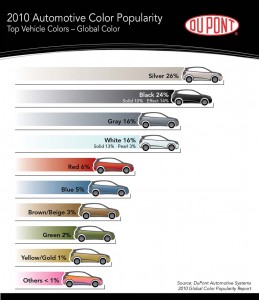 Henry Ford once told customers they could order a car in any color they wanted, “as long as it’s black.” When arch-rival General Motors came along and offered up a palette of paint colors, the upstart maker took a sales lead it still holds today.
Henry Ford once told customers they could order a car in any color they wanted, “as long as it’s black.” When arch-rival General Motors came along and offered up a palette of paint colors, the upstart maker took a sales lead it still holds today.
These days, makers know that buyers want an array of alternatives, whether they be somber black or vibrant gold. Yet, the vast majority of motorists still tend to stick to just a couple of shades, notably silver, which has dominated the automotive spectrum for several decades – and this year has accounted for 26% of the new cars, trucks and crossovers sold in the U.S., according to mega paint supplier DuPont Automotive.
Silver, which was a solid number one for most of the last decade is in danger of being dethroned, however, and Henry Ford would undoubtedly be pleased to see black making a comeback. In its various permutations, noire grabbed a 24% market share in 2010. One reason is that there’s now more than the usual glossy black to choose from. In fact, the traditional, solid version of the hue accounted for only 10% of the market, the other 14% went to what DuPont describes as “effect” versions of black.
Third on the list is gray, which some paint suppliers actually lump together with silver – which have given the traditional choice for high-line vehicles dominance once again.
White, which briefly nudged silver out of the top spot in 2007 and ’08, followed with 16%.
But beyond that, no colors managed to nudge into double-digits. Red, for example, grabbed just 6% of the market, blue just 5%, and despite their increasing popularity on small cars and sports cars, yellow and gold together managed to eke out just 1% of the demand.
Why? While there’s a growing market trend towards vehicle customization, buyers need beware that the day-glo purple that tugs their heart strings today might be hard to sell, a few years from now, as a trade-in.
Nonetheless, suppliers like DuPont are always looking to deliver new alternatives to manufacturers, and their offerings are heavily influenced by trends in the fashion industry. But other factors have a role. There are unmistakable links between such factors as politics and the economy, for example. In war time, historical data show that buyers tend to opt for more conservative shades. Meanwhile, as the environmental movement began to take hold of the popular imagination, in the ‘90s and ‘90s, greens and earthy blues surged in popularity.
Color popularity varies, meanwhile, by country, as well. White is the most common automotive paint choice in India and Japan, where it is a sign of purity. But where the streets of Tokyo were once a sea of white, other colors have been coming on strong, in recent years. White is down to 28%, in Japan, with silver, at 24% now a close second, and black also gaining ground, at 22%. Chinese buyers prefer silver, black and gray, in that order, and in that fast-booming market, nothing else, not even white, comes close.
